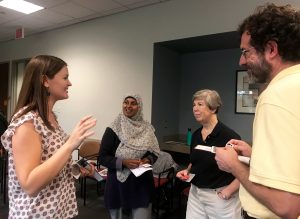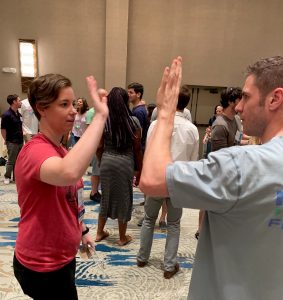Dec 04, 2018 Re-Purposing Icebreakers for Reflection and Review: Handshake Mingle and Concentric Circles
 Current brain research supports the experiential education philosophy that educators will increase attention, motivation, and learning outcomes when they weave in opportunities to get learners away from their desks or boardroom tables and move, interact, discuss, and reflect with their peers (Willis, 2015).
Current brain research supports the experiential education philosophy that educators will increase attention, motivation, and learning outcomes when they weave in opportunities to get learners away from their desks or boardroom tables and move, interact, discuss, and reflect with their peers (Willis, 2015).The default setting for reflection and review is often the leader-directed question and answer session. Many facilitators are drawn to this method because they want to make sure specific reflective questions/topics are covered and hear the entire group talking together for evaluative purposes, or because this is the way they have always done it. But it is not always the best way for learners- especially at the beginning of a group’s time together. Be aware of putting individuals “in the spotlight” to share in front of the group too early before some trust and rapport have been built.

Blending in reflective questions in more subtle ways from the very start of a group’s time together and throughout with active small group and pair share methods helps learners build comfort with each other and the group process leading to more engagement, buy-in, and in-depth reflection discussions later on. There are many innovative ways to incorporate some fun, whimsy and a more participant-centered approach to the “What?” “So, What?” question-and-answer session. These methods add a spontaneity that encourages participation from all group members, not just the extroverted hand-raisers.
Most educators and group facilitators have a repertoire of favorite introduction activities they regularly use to build rapport at the beginning of a program or school year. In recent posts, I have explored how these ice-breakers or rapport builders can be upcycled or re-purposed as active review or reflection activities throughout a program or classroom lesson.
Handshake Mingle
This has been my favorite rapport building activity and a main staple of my repertoire for many years. Over time I have changed the way I facilitate it as I’ve learned more about the brain and learning, increased awareness about the nuances of facilitation, and become more conscious of the needs of introverts in my groups. I’ve also become more intentional about using it for context setting, reflection, and review to enhance engagement and buy-in. This tried-and-true method is social and incrementally sequenced and useful for building rapport, making introductions, creating connections, reviewing names, and becoming more comfortable with each other.
Though it is playful, it starts with an action familiar in our culture, the high 5. Even reluctant group members find it palatable because I carefully facilitate it to enhance involvement by using low-risk greetings at first and taking the time for partners to return to each other to build connections with a few partners. There is choice involved, and no one person is in the spotlight. It also works as an active processing/reflection/review activity to start group dialogue on a specific experience or academic/training topic. This activity can be used a number of times throughout a group’s experience to reflect and review.
Materials: None needed, entry-task objects can be woven into this activity
Facilitation Note: Facilitators use a variety of greetings in this activity—some of them can get pretty silly. I tend to start simply, using greetings with minimal touch to warm up the group, increase buy-in, and observe the varying physical abilities of group members. I purposely facilitate a slower version of this activity, having people revisit previous partners, so they build connections with at least four or five people in the room (a very different activity than the “quickly visit everyone” version).
Facilitation Suggestions:
• First, have everyone find a partner and give each other a high 5. Have participants recognize this person as their “high 5” partner. To increase buy-in and facilitate a smooth transition from one activity to another, this first partner could be the domino or playing card partner from the pre-group or entry task pairing.
• Next, ask participants to find a new partner, and give each other a low 5. This is their “low 5” partner. I usually give these partners a reflective or get-to-know-you question, a context-setting/topical question, or ask them to share about their entry activity choice.
• After a few moments of partner conversation, have participants revisit their high 5 partner, then their low 5 partners, moving amongst the group to find those original partners.
• Then invite them to find a “fist-bump fireworks” partner (a fist bump with an explosion that brings some laughter into the activity). I often ask the group what fireworks remind them of. Inevitably someone says “celebrations.” I then ask partners to share something worth celebrating. I frame this around their reason for being in the group. For a group of educators, it could be “something worth celebrating about this school year: a personal achievement, a success story with a student, a new initiative at your school.”
• Continue this sequence, adding on new partners/activities as appropriate. You will witness laughter, positive interaction, and fun; and participants will remember their partners and conversations.
• Have participants help you come up with new handshakes or present their own; this enhances ownership and involvement. I have integrated participant’s creativity with “rock on” partners, “butterfly” partners, and “pop a wheelie” partners.
• For a deeper introductory activity or a kinesthetic reflection or review, mix get-to-know-you or reflective questions into the exercise.
• Use this as a closing at the end of a class or program: Ask participants to go back through their handshake sequence and revisit their partners to reflect on their thoughts regarding the program/lesson. Have high 5 partners share something from the program that was worth celebrating or a high point for them.
• This can be used multiple times with a group to reflect on specific questions/academic content.
Facilitation Tips: Be thoughtful and observant and use handshakes that are appropriate, taking into consideration space, physical abilities, setting, cultural norms, and the background of your group. Some of my favorite handshakes are “fishing” partners (one is the fisher with reel/rod and the other the fish) and “ankle shake” partners. BUT, I am very careful about when to introduce sillier handshakes, if at all.
 If I use an ankle shake partner, I use it to introduce/reinforce the idea or start a conversation about having choice in an experience. I always demonstrate a few different levels of ankle shaking and have them choose their own level or version. The repetitive visiting of partners is one of the most important aspects of this activity, allowing participants to create a connection with the people who are their partners and learn and reinforce names. When facilitators skip this part and focus on quantity of partners versus quality of interaction it takes away from the activity and can turn a positive,rapport-building activity into an intimidating icebreaker. Recent research on the brain demonstrates that engaging in appropriate touch such as handshakes promotes social and emotional learning and attention. With touch, there is a release of dopamine and an increase in brain activity (Linden, 2015).
If I use an ankle shake partner, I use it to introduce/reinforce the idea or start a conversation about having choice in an experience. I always demonstrate a few different levels of ankle shaking and have them choose their own level or version. The repetitive visiting of partners is one of the most important aspects of this activity, allowing participants to create a connection with the people who are their partners and learn and reinforce names. When facilitators skip this part and focus on quantity of partners versus quality of interaction it takes away from the activity and can turn a positive,rapport-building activity into an intimidating icebreaker. Recent research on the brain demonstrates that engaging in appropriate touch such as handshakes promotes social and emotional learning and attention. With touch, there is a release of dopamine and an increase in brain activity (Linden, 2015).
Resource: I learned this as a community building activity years ago from my colleague Aimee Desrosier Cochran. It has been written up many different ways in this blog and both editions of Tips & Tools for the Art of Experiential Group Facilitation 2007, 2016. An academic review and reflection variation is described in the Inspired Educator, Inspired Learner book.
Concentric Circles
 A more reserved, but active partner sharing technique for review and reflection is Concentric Circles. This kinesthetic activity can be used as an icebreaker, a discussion starter, an active reflective approach, or a closing activity. It’s an effective method to break up direct instruction in a training or teaching situation and get participants away from their desks to review academic material or topics for discussion. Each person is only asked to converse or share with one other person at a time, and everyone has the opportunity to participate. This activity can be adapted to most age or size groups. It works especially well with large groups.
A more reserved, but active partner sharing technique for review and reflection is Concentric Circles. This kinesthetic activity can be used as an icebreaker, a discussion starter, an active reflective approach, or a closing activity. It’s an effective method to break up direct instruction in a training or teaching situation and get participants away from their desks to review academic material or topics for discussion. Each person is only asked to converse or share with one other person at a time, and everyone has the opportunity to participate. This activity can be adapted to most age or size groups. It works especially well with large groups.
Concentric Circles Facilitation Suggestions:
• Divide the group in half, forming two circles with the participants facing each other in an inner circle and an outer circle.
• Ask participants to greet the person they are facing and converse about a topic, a get-to-know-you question, reflective prompt, or why they chose the object they did during the hook activity.
• You might have the inside circle take on one viewpoint and the outside circle the other. Or have participants from one department on the inside and another on the outside to facilitate communication between different groups/differing viewpoints.
• In academic settings, the inside circle could “quiz” the outside circle as a formative assessment and review. See Inspired Educator for a complete descriptor of using this with prepared index cards and tallying for feedback and assessment.
• After a few moments, or when the conversational energy diminishes, have one of the circles rotate a few places: “Inside circle move three people to your right.” Participants form new partnerships, greeting those they bypass along the way.
• For a playful version with the right group, incorporate a cooperative partner activity such as Gotcha, thumb wrestling, handshakes, or one-handed partner shoe-tying prior to or following the reflective question. This facilitates social connections.
• Invite the new partners to greet each other, and provide another topic to discuss and/or cooperative activity.
• Continue the activity; alternating movement between the inside and outside circle, followed by review/reflection questions and/or partner activities.
 Facilitation Tips: I use this activity as opposed to handshake mingle when I am in a more structured setting or facilitating conversation around a serious topic. Both activities can be used multiple times throughout a program—for building relationships and rapport at the beginning and for reflection and review later on (see Inspired Educator Inspired Learner for more academic variations). The option of placing different departments of an organization or people of differing viewpoints in the different circles is a way to ensure intra-group conversations occur. I’ve used it for data gathering and formative assessment with the inside circle interviewing, collecting, recording information, insights, opinions from the outside circle and vice versa.
Facilitation Tips: I use this activity as opposed to handshake mingle when I am in a more structured setting or facilitating conversation around a serious topic. Both activities can be used multiple times throughout a program—for building relationships and rapport at the beginning and for reflection and review later on (see Inspired Educator Inspired Learner for more academic variations). The option of placing different departments of an organization or people of differing viewpoints in the different circles is a way to ensure intra-group conversations occur. I’ve used it for data gathering and formative assessment with the inside circle interviewing, collecting, recording information, insights, opinions from the outside circle and vice versa.
Resource: I was first introduced to this activity as an icebreaker facilitated during my time in experiential education grad school in 2000 with my colleague Hutch Hutchinson. I’ve re-purposed it over the past 25 years as a reflection activity originally inspired by Luckner and Nadler’s Processing the Experience (1997). Versions are written up in Inspired Educator, Inspired Learner and Tips & Tools for the Art of Experiential Group Facilitation.
References: Linden, D. (2015). Touch: The science of hand, heart and mind. New York: Viking Press
Stanchfield, Jennifer (2014). Inspired Educator, Inspired Learner: Experiential, Brain-Based Activities and Strategies to Engage, Motivate, Build Community and Create Lasting Lessons. Bethany, Ok: Wood N Barnes Publishing
Stanchfield, Jennifer(2016) Tips & Tools for the Art of Experiential Group Facilitation. Second Edition. Bethany, Ok: Wood N Barnes Publishing
Willis, J. (2014) “Brain-based teaching at The Learning & the Brain Conference: Engaging 21st Century Minds. Boston, MA.



No Comments